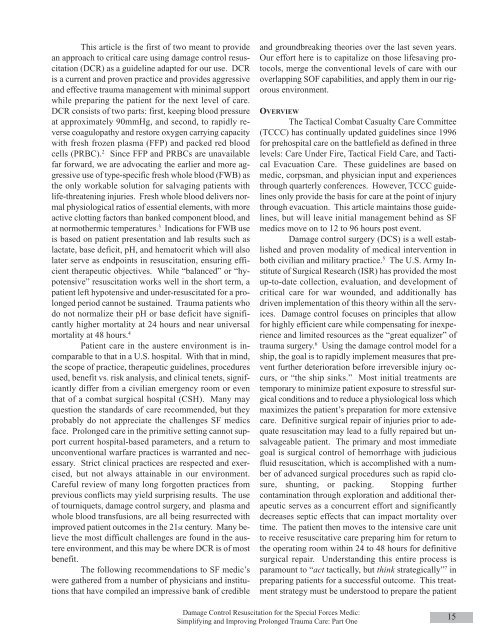Summer - United States Special Operations Command
Summer - United States Special Operations Command
Summer - United States Special Operations Command
Create successful ePaper yourself
Turn your PDF publications into a flip-book with our unique Google optimized e-Paper software.
This article is the first of two meant to providean approach to critical care using damage control resuscitation(DCR) as a guideline adapted for our use. DCRis a current and proven practice and provides aggressiveand effective trauma management with minimal supportwhile preparing the patient for the next level of care.DCR consists of two parts: first, keeping blood pressureat approximately 90mmHg, and second, to rapidly reversecoagulopathy and restore oxygen carrying capacitywith fresh frozen plasma (FFP) and packed red bloodcells (PRBC). 2 Since FFP and PRBCs are unavailablefar forward, we are advocating the earlier and more aggressiveuse of type-specific fresh whole blood (FWB) asthe only workable solution for salvaging patients withlife-threatening injuries. Fresh whole blood delivers normalphysiological ratios of essential elements, with moreactive clotting factors than banked component blood, andat normothermic temperatures. 3 Indications for FWB useis based on patient presentation and lab results such aslactate, base deficit, pH, and hematocrit which will alsolater serve as endpoints in resuscitation, ensuring efficienttherapeutic objectives. While “balanced” or “hypotensive”resuscitation works well in the short term, apatient left hypotensive and under-resuscitated for a prolongedperiod cannot be sustained. Trauma patients whodo not normalize their pH or base deficit have significantlyhigher mortality at 24 hours and near universalmortality at 48 hours. 4Patient care in the austere environment is incomparableto that in a U.S. hospital. With that in mind,the scope of practice, therapeutic guidelines, proceduresused, benefit vs. risk analysis, and clinical tenets, significantlydiffer from a civilian emergency room or eventhat of a combat surgical hospital (CSH). Many mayquestion the standards of care recommended, but theyprobably do not appreciate the challenges SF medicsface. Prolonged care in the primitive setting cannot supportcurrent hospital-based parameters, and a return tounconventional warfare practices is warranted and necessary.Strict clinical practices are respected and exercised,but not always attainable in our environment.Careful review of many long forgotten practices fromprevious conflicts may yield surprising results. The useof tourniquets, damage control surgery, and plasma andwhole blood transfusions, are all being resurrected withimproved patient outcomes in the 21st century. Many believethe most difficult challenges are found in the austereenvironment, and this may be where DCR is of mostbenefit.The following recommendations to SF medic’swere gathered from a number of physicians and institutionsthat have compiled an impressive bank of credibleand groundbreaking theories over the last seven years.Our effort here is to capitalize on those lifesaving protocols,merge the conventional levels of care with ouroverlapping SOF capabilities, and apply them in our rigorousenvironment.OVERVIEWThe Tactical Combat Casualty Care Committee(TCCC) has continually updated guidelines since 1996for prehospital care on the battlefield as defined in threelevels: Care Under Fire, Tactical Field Care, and TacticalEvacuation Care. These guidelines are based onmedic, corpsman, and physician input and experiencesthrough quarterly conferences. However, TCCC guidelinesonly provide the basis for care at the point of injurythrough evacuation. This article maintains those guidelines,but will leave initial management behind as SFmedics move on to 12 to 96 hours post event.Damage control surgery (DCS) is a well establishedand proven modality of medical intervention inboth civilian and military practice. 5 The U.S. Army Instituteof Surgical Research (ISR) has provided the mostup-to-date collection, evaluation, and development ofcritical care for war wounded, and additionally hasdriven implementation of this theory within all the services.Damage control focuses on principles that allowfor highly efficient care while compensating for inexperienceand limited resources as the “great equalizer” oftrauma surgery. 6 Using the damage control model for aship, the goal is to rapidly implement measures that preventfurther deterioration before irreversible injury occurs,or “the ship sinks.” Most initial treatments aretemporary to minimize patient exposure to stressful surgicalconditions and to reduce a physiological loss whichmaximizes the patient’s preparation for more extensivecare. Definitive surgical repair of injuries prior to adequateresuscitation may lead to a fully repaired but unsalvageablepatient. The primary and most immediategoal is surgical control of hemorrhage with judiciousfluid resuscitation, which is accomplished with a numberof advanced surgical procedures such as rapid closure,shunting, or packing. Stopping furthercontamination through exploration and additional therapeuticserves as a concurrent effort and significantlydecreases septic effects that can impact mortality overtime. The patient then moves to the intensive care unitto receive resuscitative care preparing him for return tothe operating room within 24 to 48 hours for definitivesurgical repair. Understanding this entire process isparamount to “act tactically, but think strategically” 7 inpreparing patients for a successful outcome. This treatmentstrategy must be understood to prepare the patientDamage Control Resuscitation for the <strong>Special</strong> Forces Medic:Simplifying and Improving Prolonged Trauma Care: Part One15
















